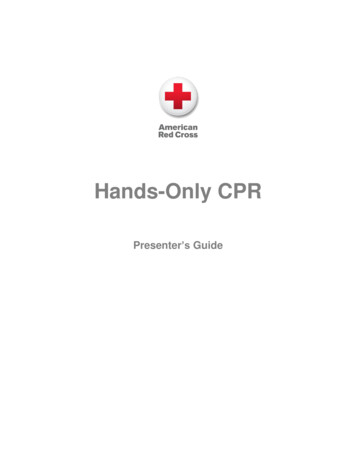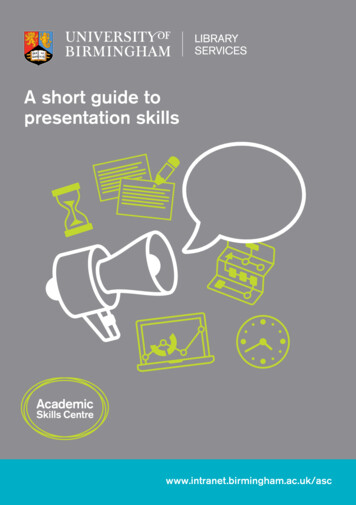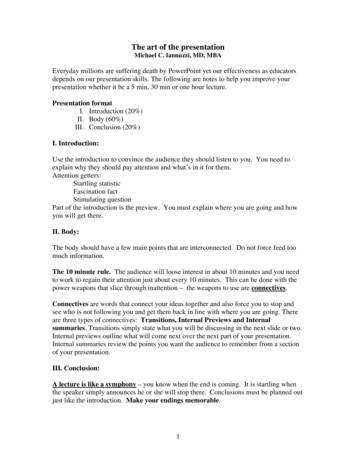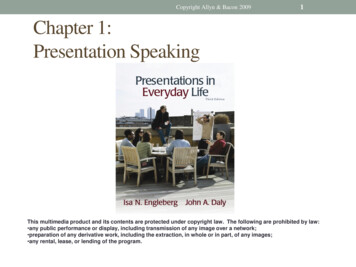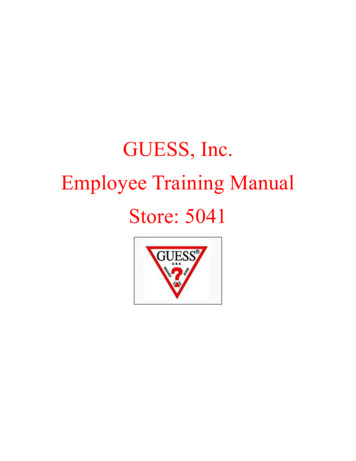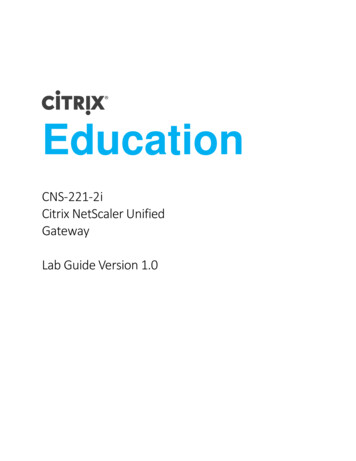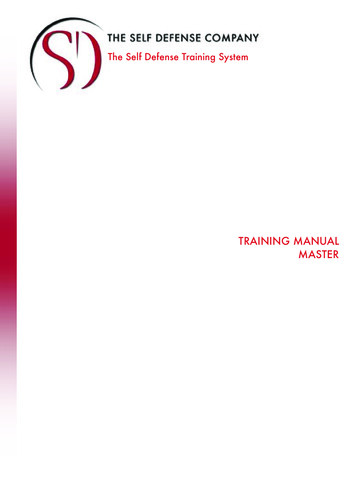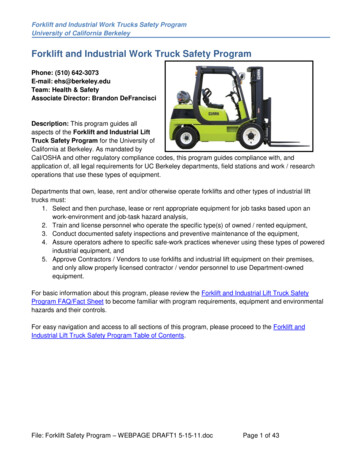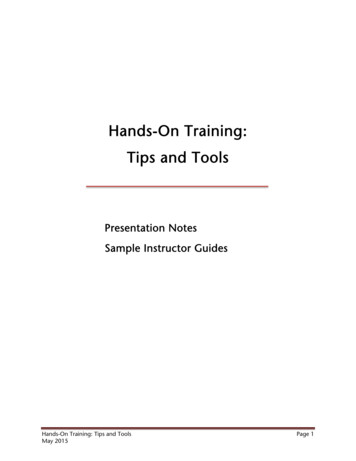
Transcription
Hands-On Training:Tips and ToolsPresentation NotesSample Instructor GuidesHands-On Training: Tips and ToolsMay 2015Page 1
This brief presentation provides some tips and toolsfor the effective use of hands-on training in yourdepartment. As proven by both research andexperience, the simple act of structuring on-the-jobtraining greatly increases its efficiency andeffectiveness.The workshop agenda is presented here. Beginningwith a brief overview of hands-on training, we willquickly move into a look at some specific tools ortechniques that are commonly used by instructorswithin the context of hands-on training. Some ofthese govern the instructor’s basic approach to HOTand may not be obvious to trainees. Others aremore procedural in nature and help the instructorcarry out certain tasks during the training.From there, a variety of sample instructor guides which describe how to do the trainingwill be provided. If you choose to use them, these guides will likely need to bemodified to be most applicable in your training, but they all describe a basic step-bystep ‘‘recipe’’ for you to get started.Then we will wrap up our time together with any additional questions or thoughts youmight have on the topic.Much of the information presented here is adaptedfrom the book cited on this slide and written by GarySisson. He states, ‘‘In a very real sense, hands-ontraining is nothing more than an orderly approach tosomething that is going to happen anyway.’’It is simply human nature to learn. With or withouta sound structure in place, inexperienced workerswill try to learn their jobs from experienced workers.Hands-On Training: Tips and ToolsMay 2015Page 2
HOT works best when it is integrated as a normalpart of work. In this sense, HOT looks far less like atraining program and more like an ongoing supportsystem akin to equipment maintenance or qualityassurance. It is a very effective method foraccomplishing a function that must be accomplishedanyway. A simple training system, supported by asimple method and simple rules, stands a far betterchance of success in the workplace than a complex training system that requires heavymaintenance and administration.An easy acronym to help remember and use thebasic structure of HOT is HOT POPPER. The specificsteps are listed here. Even though six distinct stepsare involved, the underlying principle is one ofsimplicity. As already mentioned, the general ruleof thumb is that the more complex the trainingsystem, the less likely HOT will work.All too often well-intentioned trainings fail to reachtheir goals because of a lack of attention to the first and last steps. Professionals facedwith training individuals on-the-job are sometimes prone to enter the situation withoutstructuring how the event will proceed. ‘‘I will just show her how I do this task and giveher a little practice,’’ is sometimes the extent of the preparation. ‘‘I have beenperforming this task for years and know it forward and back.’’Unfortunately, while this may be true, performing the task is not actually therequirement at this point. In this case, the veteran employee’s primary task is training ,not performing the task.Prepare:Training may not be the task the professional spends a great deal of time doing andpreparation may include assembling examples of completed work in advance (bothgood and bad samples), checking the equipment that will be used, protecting the areafrom interruptions, creating an easel chart outlining the main points, etc.Carefully determine the anticipated outcome of the training. How well should thetrainee perform, how quickly, under what conditions? These considerations will bevaluable in the evaluation step.Hands-On Training: Tips and ToolsMay 2015Page 3
Open:When training people whom you do not know, begin with appropriate welcomes andintroductions. This is not necessary, of course, if you have been working together for atime. However, even within good working relationships, the trainee may feel someanxiety learning new skills and some sort of welcome can mitigate worries and unease.Ask the trainee how he feels about the upcoming task and then introduce the topics tobe addressed. This is where the preparation begins to pay off. The task should bebroken down into appropriate components that may include the work process itself,safety, quality, cleanliness, thoroughness, and so forth.Present:This step can vary greatly, of course, depending upon the topics involved. For instance,a training session focused on workplace safety will differ tremendously from a telephoneskills training. However, in both examples it is important to stick to the main steps onlyand answer questions from the trainees. You may defer some questions till later toprotect the linear development of a process, or you may choose to interrupt the processmomentarily. Clarity of the topic must always be considered.This is also the step during which you may produce examples of work for illustration.Include both good and bad samples when possible.Practice:This step is often combined with the next step --- Evaluate --- because it is nearlyimpossible to observe your trainees practicing what you have presented withoutsimultaneously assessing their performance. However, the two steps are still twodistinct activities. You should position yourself where you can see the trainee’s workclearly and ask questions to make sure the trainees understand what they are doingwhile performing the tasks. Offer coaching and tips on how to improve, but be carefulnot to overwhelm the trainee as they practice new skills. Have each trainee practiceeach task at least twice and continue practice until you are satisfied with theperformance.Evaluate:Remember your expectations regarding performance and use those to help with theevaluation process. Remain as objective as possible and rate the performance based onthese predetermined objectives.Review:Briefly review the main points of the session. Describe what you believe the traineeshould now know and be able to do. Indicate if additional practice and review sessionswill be provided. Ask and answer any final questions.Hands-On Training: Tips and ToolsMay 2015Page 4
Now let’s look at several of the tools and techniquescommonly used by instructors within the context ofHOT. As with the HOT POPPER method itself, mostof these tools are simple and straightforward. Theydo not require a lot of complicated reasoning andmost people can readily understand and use themto increase training effectiveness.In fact, the more difficult question is when to usethese tools, not how to use them. In a few cases the answer is obvious. For example,one of the tools (Daily Routine) describes a simple pattern to follow if your training lastsseveral days. When do you use it? Every day. But others, such as Question-and-Answersessions and Self-Critiques must be initiated by the instructor on the spot------when calledfor by the situation.This means that the instructor must have these tools available (i.e., know them),recognize when it is time to pull one out of the tool kit, and then apply it to thesituation at hand.The show and tell method is familiar to all, butcertain aspects can benefit from attention.Provide clear visibilityPositioning so the trainee can see everything clearlyis often a challenge. It is compounded whenmultiple trainees are present. Also be aware of themirror image when important. If you trainees faceyou, your left hand is on their right and may lead to confusion.Use slow, distinct movementsWhen showing physical skills and other actions that may be difficult to follow, go slowlyand narrate what you are doing. Missing one critical step often impacts all subsequentsteps. A particularly good example of this is often seen when demonstrating computerskills. The instructor may move the mouse/cursor and make selections more quicklythan trainees can track.Hands-On Training: Tips and ToolsMay 2015Page 5
Be heard without shoutingIt is important to be heard, of course, but not appropriate to try to yell overbackground noise. Whenever possible, move the training to the quietest locationavailable.Split locations for differing purposesLoud, distracting environments may be unavoidable for some training. In these cases,investigate the possibility of conducting some of the training steps described byPOPPER in a quiet area and moving to the noisy one when necessary.Use samples effectivelyBoth good and bad examples often help the trainee learn. However, often the trainee isstill examining a sample that is being passed around when the instructor moves on tothe next point. Allow ample time to examine and ask questions.The skill of asking and answering questions iscertainly one of the most important skills aninstructor can use. The kind of questions you ask,the words you use, and the tone of your voice allaffect the answers you are likely to get. As aninstructor, you will soon begin to realize thatquestions are a powerful tool. But you also willbegin to see that questions are easily misunderstoodby trainees. That's one of the frustrations that gowith two-way communication.As with any other skill, the more you practice, the better you become at askingquestions. Ask lots of questions. They keep trainees involved, make people think andgenerally contribute to better training.FeedbackQuestions are one of the best ways to give and get feedback. They create involvementin the training through a dialogue between the instructor and the trainee.Multiple objectivesThrough effective questioning, the instructor can review material, check understanding,start a discussion, get opinions, draw out personal experience, etc.Hands-On Training: Tips and ToolsMay 2015Page 6
‘‘Thinking’’ questionsThe best questions are those that require trainees to think. Questions that start with"Why?" or "How?" or "What do you think about?" are usually the best. Those that canbe answered with a simple yes or no are usually the weakest. Questions are usually mosteffective when they are asked in "chains." In other words, the answer to one question isfollowed up with another question.In general, a series of connected questions is better than a "one question, one answer"parroting routine. Usually the follow-up questions go deeper into the previous answer.They expand it, test it, or (in the case of a group situation) give other people a chanceto express their opinions. This is the essence of dialogue.Most of the time an instructor has an answer in mind when he or she asks a question.On the other hand, most questions have more than one good answer. A goodinstructor is willing to accept an answer that may be different from the one he or sheexpected------especially if the other answer makes sense. If you insist that only your ownanswers are right, you will be regarded as a rigid instructor.If a trainee doesn't know the answer to a question, it is your responsibility to help thetrainee. Instructors aren't perfect! Sometimes you might ask a question that nobodyunderstands but you. The best policy is to automatically assume that you asked a badquestion. Rephrase the question and ask again. Then, if your trainee can't answer, askyourself what's wrong. Sometimes even the best instructors must answer their ownquestions.Don’t be trickyTry to avoid tricky questions that trap people. These tend to embarrass others, and theyusually don't help people learn the subject. In fact, trick questions usually end upmaking the instructor------not the trainee------look foolish.It is normal for the instructor to know more about the subject than the trainee.Otherwise, why do the training? But some questions are impossible for the trainee toanswer. They are beyond the trainee's knowledge. The rule of thumb is that hardquestions make people think, but impossible questions just make them discouraged.Use appropriate toneWhen you ask questions, listen to the tone of your voice. The nature of a question candepend on how it sounds to others. For example, you could ask the question, "Wherewere you at eight o'clock?" If you used a "normal" tone of voice, the person you askedwould probably give you a direct answer. But you could easily ask this question in atone of voice that sounds like you're accusing the other person of being in the wrongHands-On Training: Tips and ToolsMay 2015Page 7
place. Your emotions are expressed in the way your voice sounds. This can put theother person on the defensive and negatively affect your communication. It is best toask questions without letting emotion show in your voice.Coaching is the process of guiding others to helpthem reach their full potential. It is a process ofshaping or steering performance toward desirablegoals. It is possible to have training withoutcoaching and coaching without training. In HOTPOPPER, however, training and coaching are usedtogether to help the trainee achieve jobperformance objectives.In HOT, coaching is entirely positive and intended only to help a person improve. Harshcriticism and sarcasm are highly inappropriate. They detract from the learning ratherthan helping accomplish the objectives.In HOT, coaching usually happens during the practice step and again during theinstructor's follow-up, after the formal training ends. When done effectively, coachingfollows a five-step pattern that you can remember by recalling the word coach.C Continue PracticeThe instructor has the trainee perform a task.O Observe and EvaluateAs the trainee performs, the instructor observes carefully and evaluates performance,noting what the trainee does right and also what needs improvement. The instructordoes not interrupt unless the trainee performs an unsafe act or makes a very seriousmistake. During the performance, the instructor offers encouragement when the traineedoes a step correctly.A Affirm Positive PerformanceWhen the trainee is finished, the instructor compliments the trainee on what went rightand then assigns the trainee to repeat the performance.C Communicate Ideas for ImprovementJust before the trainee is ready to perform again, the instructor offers advice,suggestions, or tips on how to improve. These are based on observations of thepreceding performance, and they must be very specific in order to be helpful. TheHands-On Training: Tips and ToolsMay 2015Page 8
instructor also may choose to show the trainee how to improve, rather than merelyexplaining this.H Help Until SatisfiedThe trainee then repeats the performance, trying out the instructor's advice.Meanwhile, the instructor continues to observe, evaluate, and offer encouragement.The instructor might choose to have the trainee repeat only certain steps of the job inorder to accelerate experience. If so, the trainee's final performance should cover theentire job or task.This coaching pattern is repeated until the instructor is satisfied that the trainee canperform as expected.The HOT coaching technique is intended to be a positive process. For that reason,criticism, in the normal sense, is avoided. Mistakes are dealt with by offering help onhow to improve and certainly without dwelling on them. By keeping your coachingpositive, you will find that trainees make fewer mistakes and learn faster. Coaching isone more factor that increases the power of HOT POPPER.The fundamental principle behind the self-critiquetechnique is that a mistake has only one value: whatcan be learned from it. As the instructor, your jobis to ask the trainee three simple questions: "Whatwent right?" "What went wrong?" "What did youlearn?" Then, as the trainee answers, you can offerencouragement as well as advice.A self-critique allows the trainee to review andevaluate his or her own performance. It also is a means of allowing the trainee to saveface by pointing out his or her own errors. In fact, the normal tendency is for trainees tobe overly critical of their own performance. As the instructor, your job is to steer thecritique toward positive results. Do not allow the trainee to gloss over the first question("What went right?") or dwell on the negative aspects of performance. Instead, use theself-critique as a means of wrapping up a practice session. Then provide your owncoaching and have the trainee repeat the practice until you are satisfied.Hands-On Training: Tips and ToolsMay 2015Page 9
Hands-On Training is often spread out over severaldays, sometimes even weeks or months. The sameinstructor and trainee work together as a team untilthe trainee can do an entire complex job. In thesecases, it is more than likely that the training will beinterspersed with work, rather than having one longstring of continuous training sessions.A daily routine will help maintain the necessarybalance and enhance progress toward the goal of establishing the trainee’s selfsufficiency on the job. This simple routine has three elements that can be arranged inany order to fit the situation. You can remember the parts of the routine by recallingthese three words: New, Review, Do. Here's how it works: Every day, spend time helping your trainee learn something new. The goal is tomake at least some progress every single day. Spend part of the day reviewing subjects covered before. This may entail havingthe trainee repeat practice sessions from earlier days, it may require you to repeatearlier demonstrations, or it may involve the two of you sitting down and goingover some of the material covered in earlier sessions. Another part of the day should be spent doing some productive work. This willbecome easier as the trainee learns more and is able to perform more tasks.The order of these three segments and their lengths may vary from day to day. Thevalue of this daily routine is that it provides variety while encouraging progress towardthe goal.An instructor guide is a step-by-step "recipe" forinstructors to follow when conducting training.Some instructors use different names, such as lessonplan, training plan, facilitator's guide, and so on, butthey all refer to the same thing: a document thatdescribes how to do the training.Hands-On Training: Tips and ToolsMay 2015Page 10
Four sample guides are provided here for yourconsideration. They are structured around a fourphase training sequence to help you decide when tocover different subjects. Appropriate steps of theHOT POPPER method are combined with theapplicable instructor guide to deliver training withineach of the four phases.Phase 1: Job OverviewExplain what the job is. Show the trainee the work area. Cover subjects such as theoutputs or products of work, safety and quality issues, performance expectations,objectives, and how the training will work.Phase 2: Equipment FamiliarizationCover information about the tools and equipment used on the job. These may includeactual hardware and machinery. But they also may include software, forms, referencematerials, and anything else that is used to help accomplish the work. The point here isto acquaint the trainee with the language of the job, where materials are located, andgenerally how they work before getting into the details of actually doing the job.Phase 3: Task TrainingUse HOT POPPER to cover each job procedure. Ifthe job entails complex setup procedures, cover thenormal operating procedures first, then return tothe more complicated setup tasks. This way, thetrainee will find the setup tasks easier to learn. Savetroubleshooting tasks for later in this phase oftraining. Again, the reason is that it is usually easierfor a trainee to deal with exceptions after he or shealready knows how to do the job under normaloperating conditions.Phase 4: Solo PerformanceOnce the trainee has successfully practiced each task by itself, put the process backtogether by having the trainee do the entire job under the most realistic conditionspossible. The length of this phase depends upon the complexity of the job. The morecomplex, the longer the solo. The solo phase is often used for job qualification orHands-On Training: Tips and ToolsMay 2015Page 11
certification. In addition, it allows the trainee to build confidence and prepare for thetransition from training to work.In summary, three very common situations may callfor the application of HOT: evolution, revolution,and execution.Evolution is the situation where Hands-On Trainingcan be used to cover the everyday incrementalchanges that make an organization tick. This couldmean that the system changed over time or we justfound a better way of working, as in a continuousimprovement situation. Hands-On Training is a great way to "spread the word."Revolution is where Hands-On Training may be used to teach people from scratch. Thisrefers to the revolutionary change from "can't do" to "can do." It may involve a brandnew employee, an entirely new product or process, or an experienced person on a newjob. In many cases, Hands-On Training is the only training option available.Execution refers to the use of Hands-On Training to facilitate the transfer of trainingfrom the classroom to the job. Hands-On Training is used as a follow-up to other typesof training in order to help the trainee make the transition from practicing to properlyexecuting the job in the workplace.If you think in terms of these three situations, you'll see that the opportunities for usingHands-On Training are countless. They surround you every day. All you have to do ischoose. Some of the opportunities are obvious and important while others are moresubtle, but every application of hands-on training is a "reach out and touch someone"situation.Hands-On Training: Tips and ToolsMay 2015Page 12
Instructor Guide 1: Job Overview(If you are starting with a new trainee, this is the first instructor guide to use. Its purposeis to open the entire training process by covering "the basics," as an introduction ororientation to both the training and the job. This is where you set the tone for trainingby covering topics such as quality, safety, the overall work process, performancestandards, and how the training will work. The job overview presents the big picture,helping the trainee to understand where he or she fits into the organization and theflow of work. This lays the groundwork for the more specific training that follows.)Prepare1. Make up a set of samples of the following:o Good quality outputo Poor quality outputo Quality specifications/printso Quality measurement devices/gauges used2. Get safety equipment for each trainee.3. Set up a quiet training area with chairs for each trainee and instructor. (Thiscould be a break area.)4. If you wish, make a flip chart or overhead of the main points to cover duringeach part of the session to help keep you on track. If you do this, you willhave to make sure the equipment is available for your session. The sessioncan cover:oooooJob safetyA basic introduction to the jobQualityCleanliness and housekeepingHow the training will work5. Get training manuals or copies of materials that will be used by trainees asneeded.6. Check the work area. Make sure it is presentable.Open1. Welcome each trainee:o Explain that this session will help trainees get started but that most of thetraining will be done in the workplace.o Make appropriate comments to reduce any worries the trainees haveabout being in a new situation. It may take a few minutes to calm themdown.2. Introduce yourself and any other instructors.o Each instructor should tell his or herHands-On Training: Tips and ToolsMay 2015Page 13
NameJobRole as a Hands-On Trainer or a presenter in this sessiono Each instructor should comment on the importance of the training and hisor her personal commitment to helping trainees learn their jobs.3. Ask the trainees to introduce themselves. Have each one tello His or her nameo Something about his or her work backgroundo How he or she feels about this job.4. Introduce the topics that will be covered in this session:o Safetyo An overview of the work processo Qualityo Cleanliness and housekeepingo How the training will work5. Ask if there are any initial questions, and answer as needed.Present: SafetyNote: Jobs vary greatly when it comes to safety. Cover only those safety topics thatapply to your particular situation.1. Explain that there are several really important safety factors on this job.2. Cover the following as they apply to the job:o Noiseo Eye safetyo Personal protective equipment (hand out as needed)o Moving parts and pinch pointso Knives, blades, or other sharp objectso Electrical shocko Lock out/tag out procedureso Fumes and dusto Hazardous materialso Floor hazards and fallso Safety around vehicleso Safe driving practiceso Lifting procedureso Fire hazardso Explosive hazardso Climbing and fallso First aido Emergency procedureso Other topics based upon your experienceHands-On Training: Tips and ToolsMay 2015Page 14
Present: Work Process OverviewNote The point in this session is just to familiarize trainees with the work process andthe area, not to give the details.1. Take trainees to the work area.2. Briefly show and explain how the work is done:o Stick to the main steps only.o Answer questions as you go. You will need to defer many of the answerstill later in the training. Don't be afraid to explain that you'll coversomething later.o Review safety and point out areas of specific hazards.3. When the tour is complete, take the trainees back to the training area.Present: Quality1. Explain the importance of quality:o Explain the organization's quality policy and/or philosophy (sometimes itis best to have specialists do this part).o Explain the trainees' personal responsibilities for quality.o Hold a question-and-answer session.2. Distribute and briefly explain the set of product samples:o Show examples of both good products and defects.o Let trainees handle the samples for a few minutes, then collect thesamples.o Hold a brief question-and-answer session.o Show and explain samples of product specifications/prints, and explainwhere these are located.o Show and explain any special measurement devices (instruments, rulers,tapes, gauges, etc.).o If there is time, have trainees use them.o Tell trainees that you will explain more about quality and how to maintainit as the trainees learn the job.3. Demonstrate how too Inspect the work outputso Fill out quality formsPresent: Cleanliness and Housekeeping1. Explain the importance of good housekeeping:o It helps prevent accidents.o It helps maintain quality.o It is important for the organization's public image.2. Briefly cover the expectations for cleanliness and housekeeping.Hands-On Training: Tips and ToolsMay 2015Page 15
3. Explain that you will cover a lot more on housekeeping as they learn the job.For now, list the various housekeeping issues that will be covered later in thetraining.4. Ask and answer questions as needed.Present: The Training Process1. Explain how the training will work. Explain that you will cover the followingsubjects:oooEquipment familiarizationBasic work proceduresPractice doing the job2. Explain that most of the training sessions will use the following pattern:o Opening to introduce the subjecto Presentation of information about the subjecto Practice of skills and procedureso Evaluation and coaching from the instructoro Review of the session3. Explain that most of the training will be Hands-On Training done in the4.5.6.7.8.work area.Tell the trainees that you expect them to ask lots of questions and get reallyinvolved in the training. Explain that it is better to ask questions and makemistakes now than once they're on the job.Explain the objective/goal of training.Explain how trainees will be evaluated at the end of training.Ask if they have any questions about how the training will work, and answeras needed.Hand out and explain any training materials to be used.ooExplain how they are to be used.Cover the policy on returning them after training.Review1. Briefly review the topics covered during this session:o Safetyo Work processo Qualityo Cleanliness and housekeepingo The training process2. Answer any final questions.3. Move on to the next session.Hands-On Training: Tips and ToolsMay 2015Page 16
Instructor Guide 2: Equipment Familiarization(The first specific topic for training should be the language, nomenclature, and jargonused on the job. So we start by covering all of the hardware, software, tools, andmaterials that will be used or referenced by the trainee. Needless to say, this will varygreatly from one job to another, but the purpose of equipment familiarization trainingis always the same. It is to help the trainee learn what things look like, where they arelocated, and what they are called. The reason for covering the equipment before thework procedures is to build a foundation and vocabulary that will support both theinstructor and trainee as they move forward. If the trainee knows this information, thetrainee and instructor will be on the same wavelength as training progresses. Thisavoids the very confusing method of trying to cover both nomenclature and proceduresat the same time.)Prepare1. Make sure the work area is presentable.2. If you have equipment documentation, use it.3. If you don't have equipment documentation, make a list of items to cover.Include items such asooooooooooooHardware and mainfeaturesSoftware systemsDocumentationOffice equipmentMachines, main features,and controlsToolsInstrumentsGaugesFixturesFastenersRaw materials and suppliesChemicalsoooooooooooooParts and subassembliesVehicles, main features, and controlsConstruction equipmentProtective clothing and equipmentStorage areas and devicesHousekeeping equipment andsuppliesTransportation systemsControl systemsMaintenance equipmentSecurity systemsEmergency equipmentUtilitiesInformation processing systems4. If you wish, set up a display of tools and/or equipment used on the job.Open1. Explain that this session is about the equipmento Systemso Main featureso Controlso Tools of the tradeHands-On Training: Tips and ToolsMay 2015Page 17
2. Tell the trainees
Offer coaching and tips on how to improve, but be careful not to overwhelm the trainee as they practice new skills. Have each trainee practice each task at least twice and continue practic
